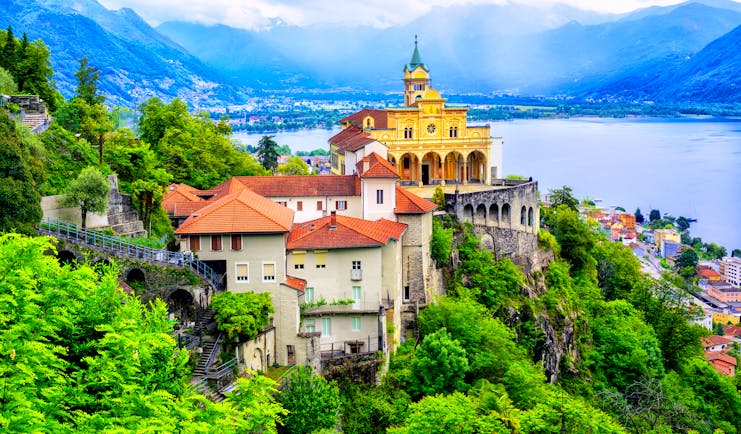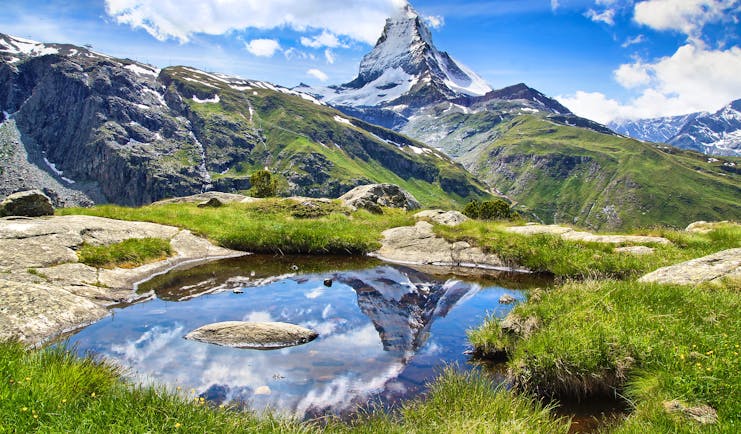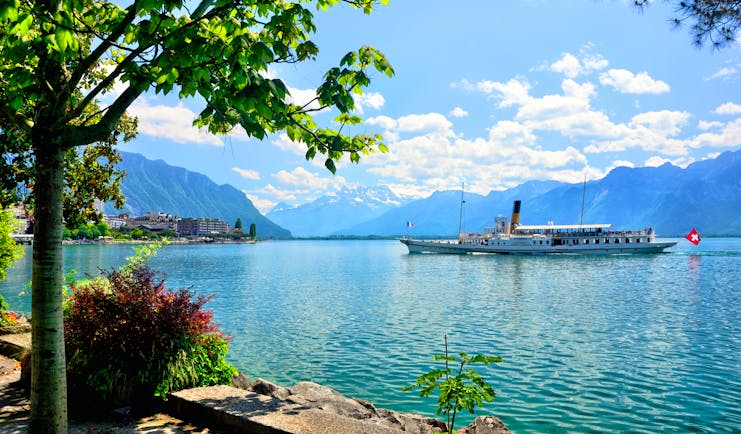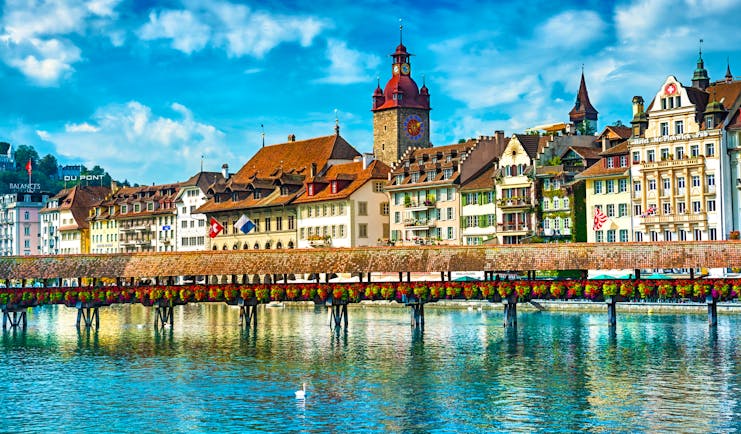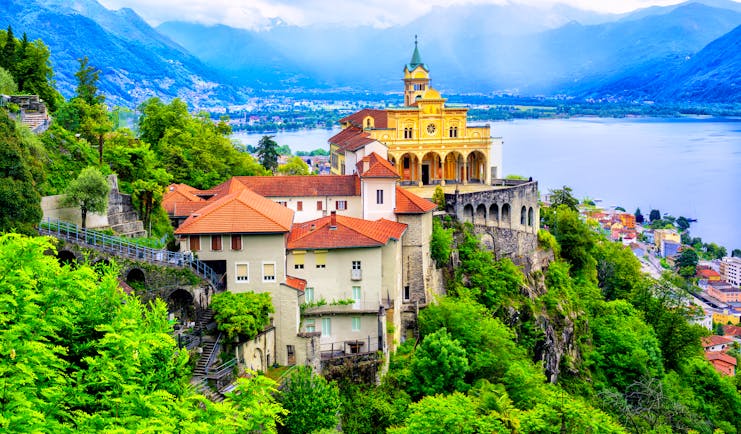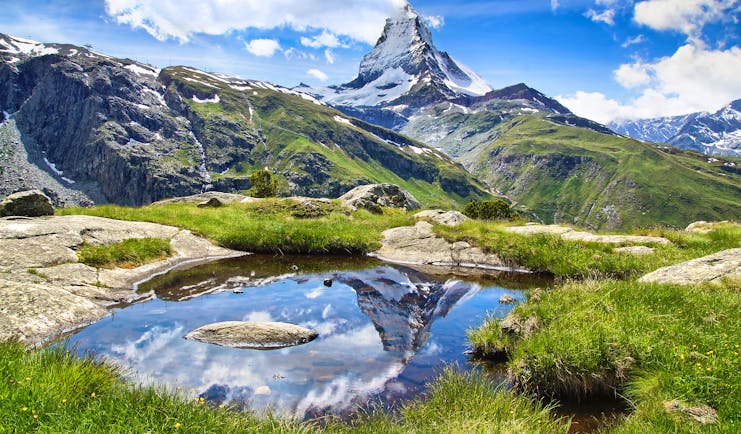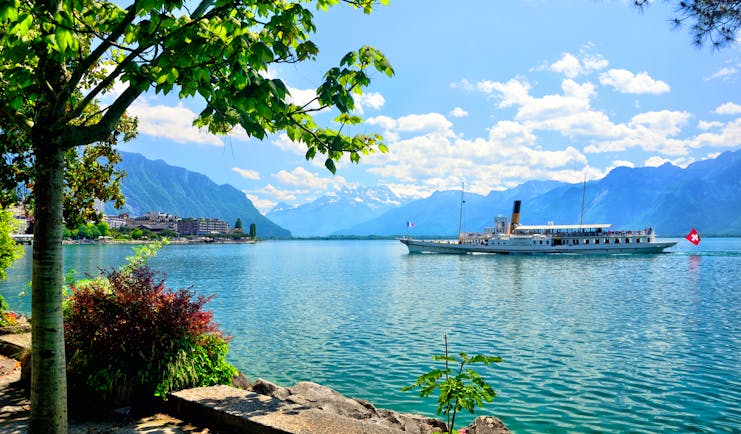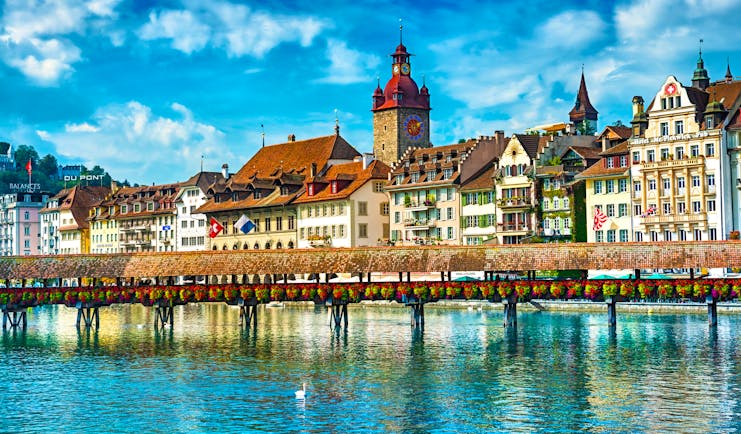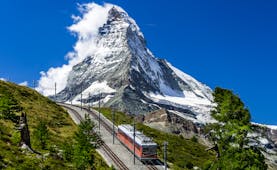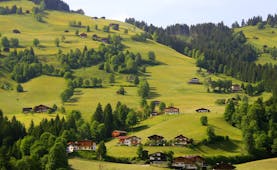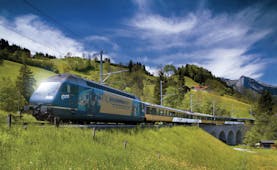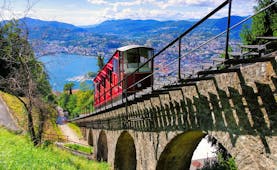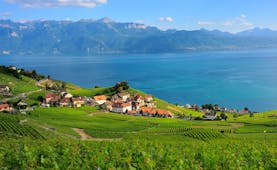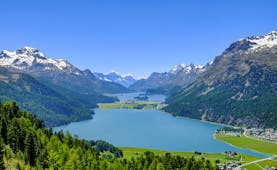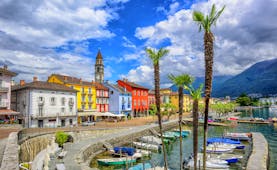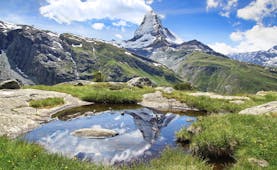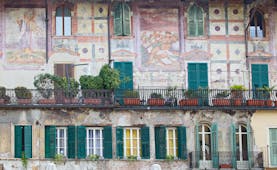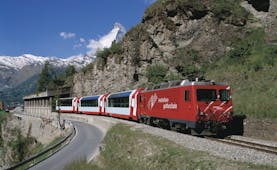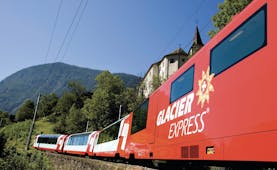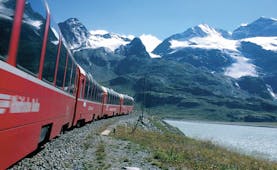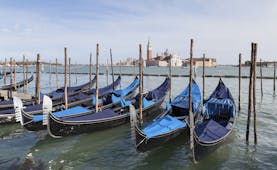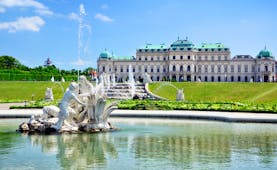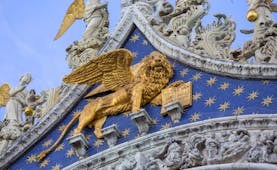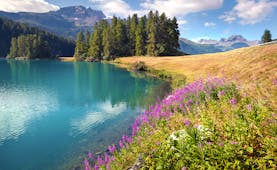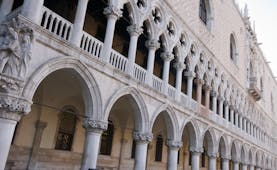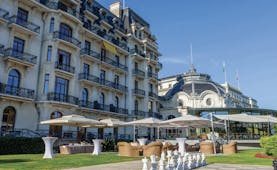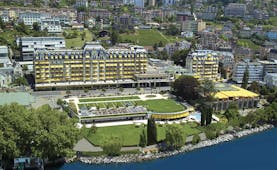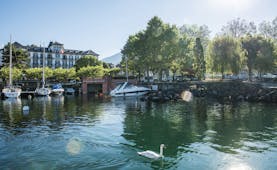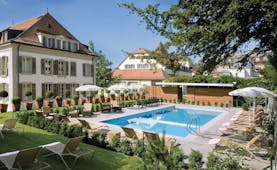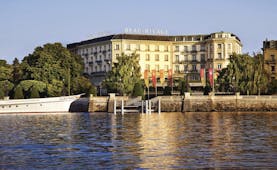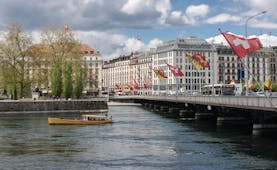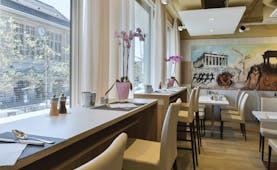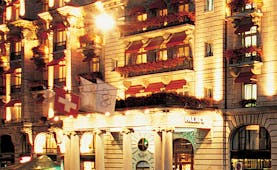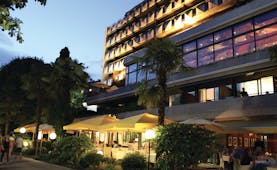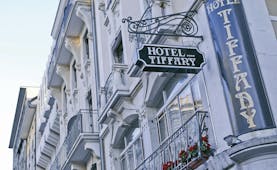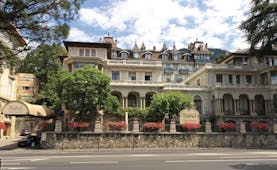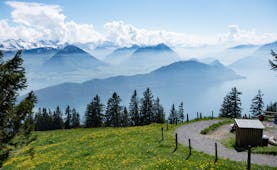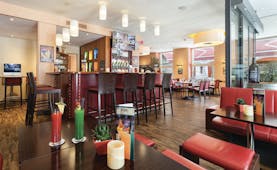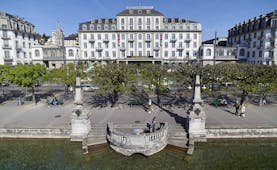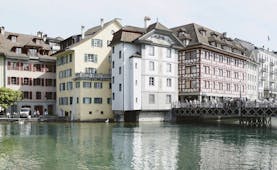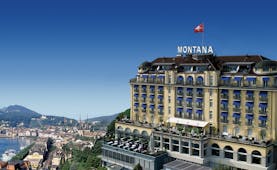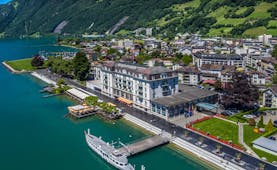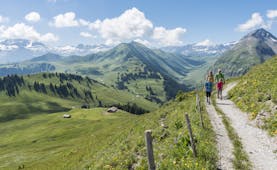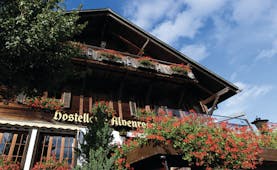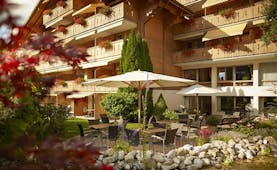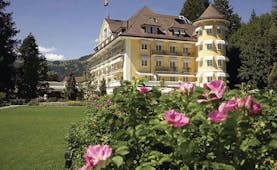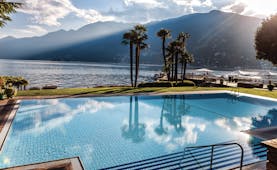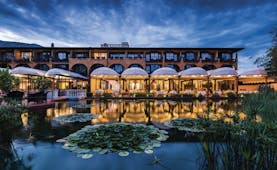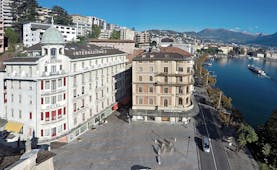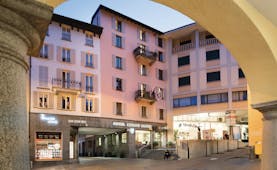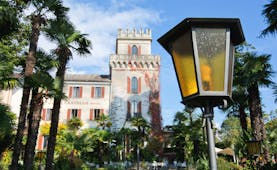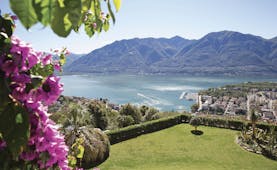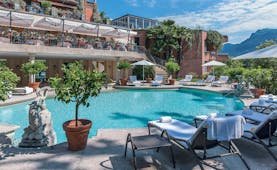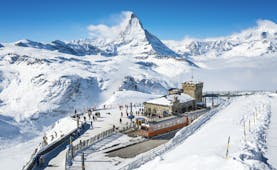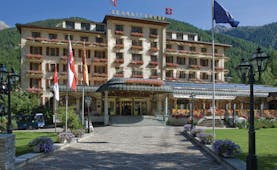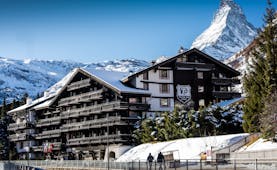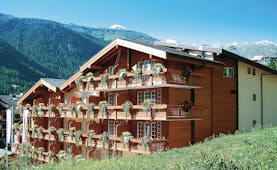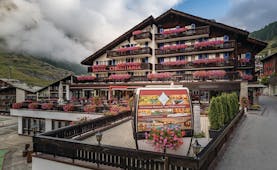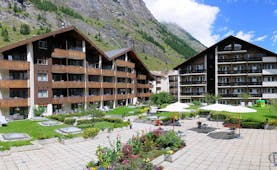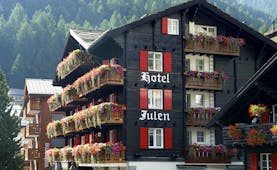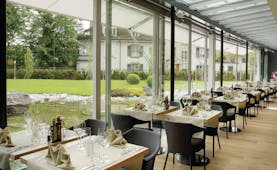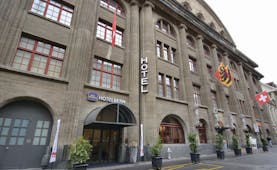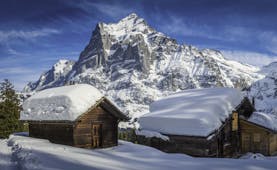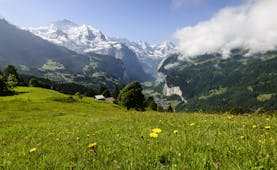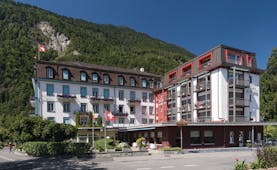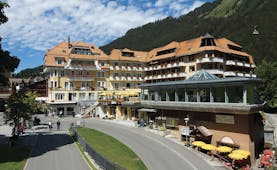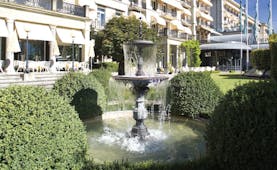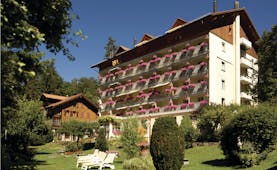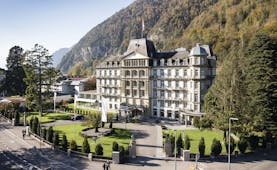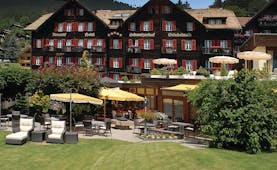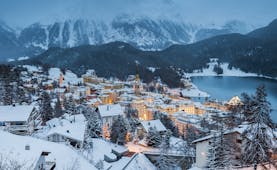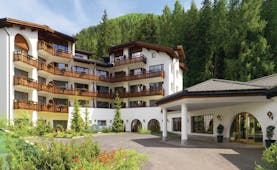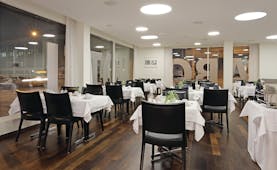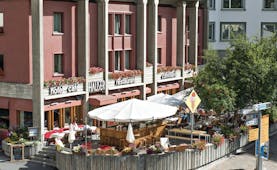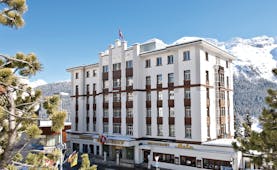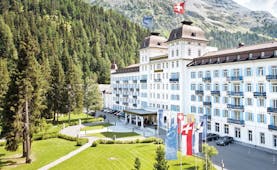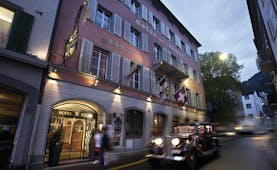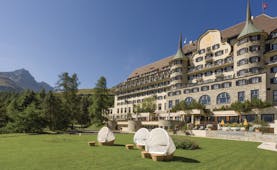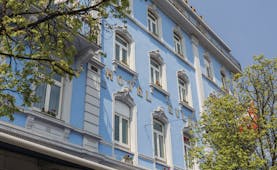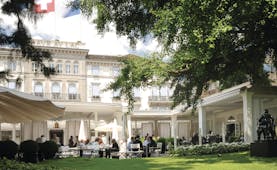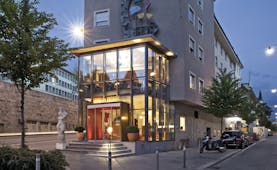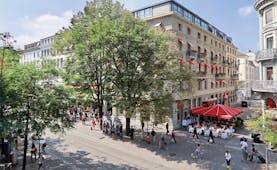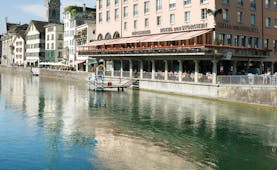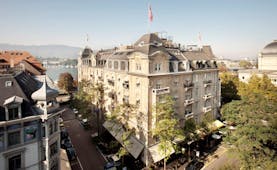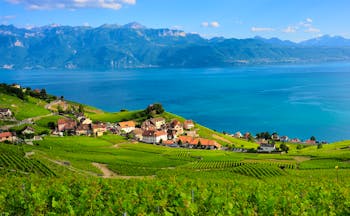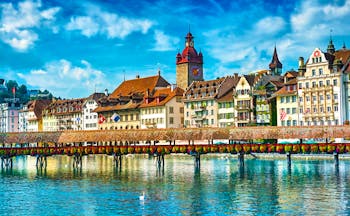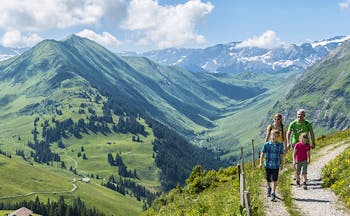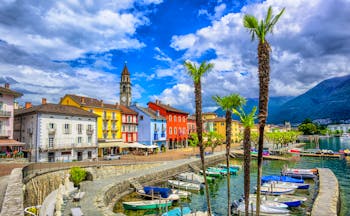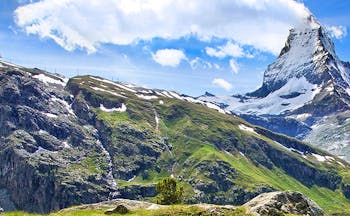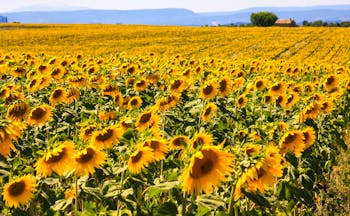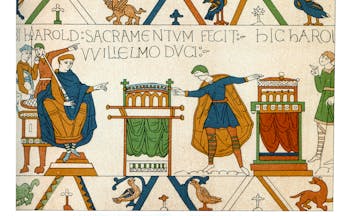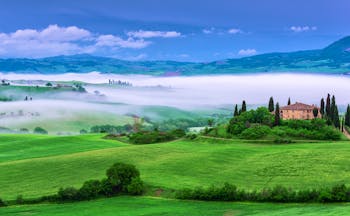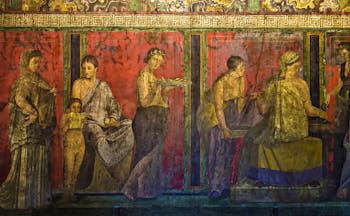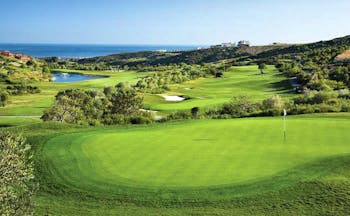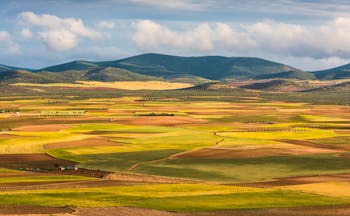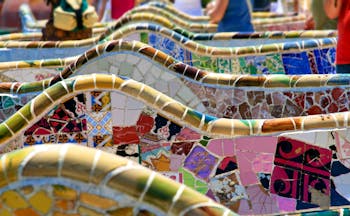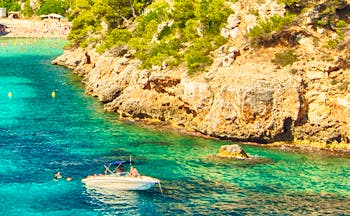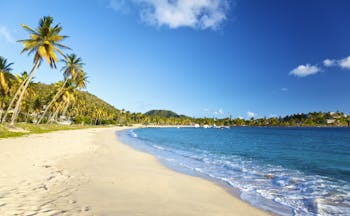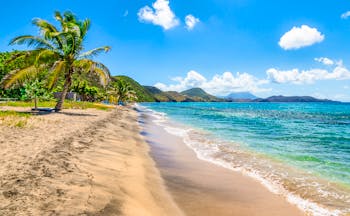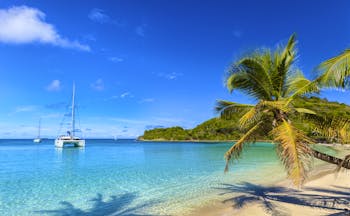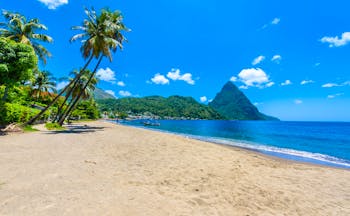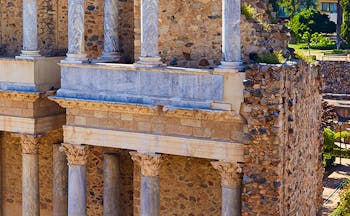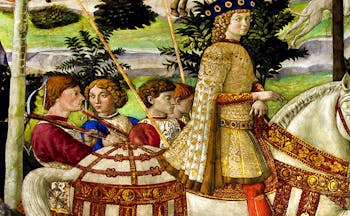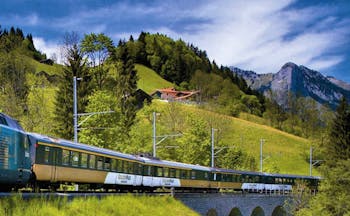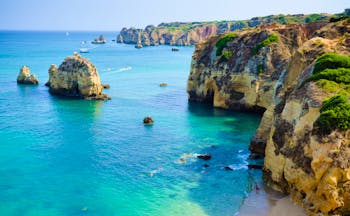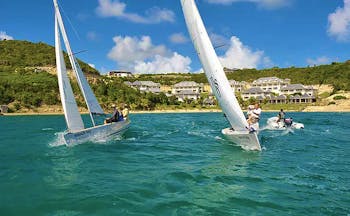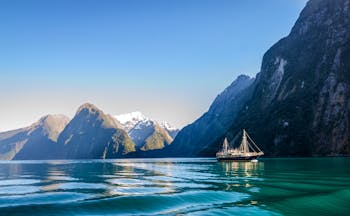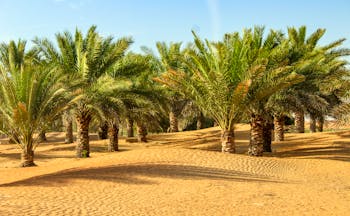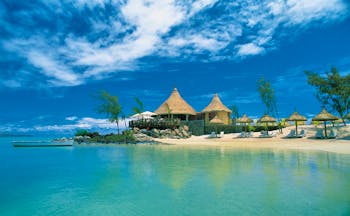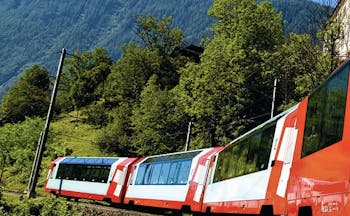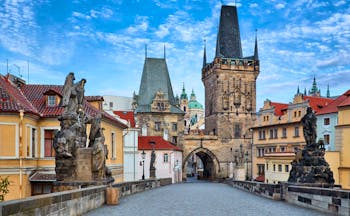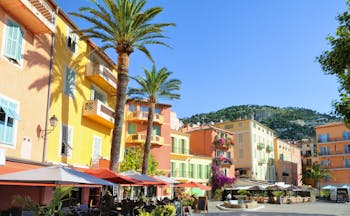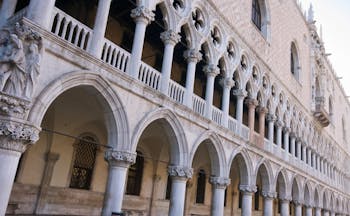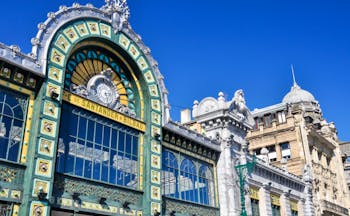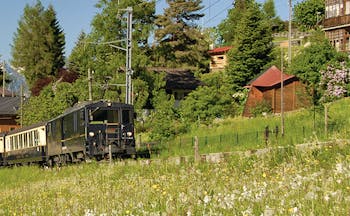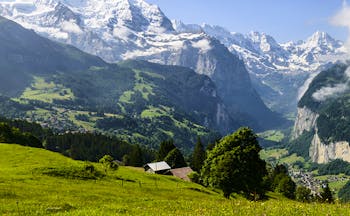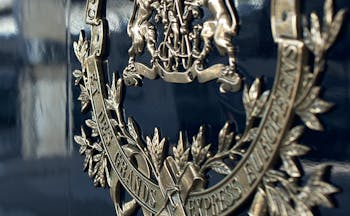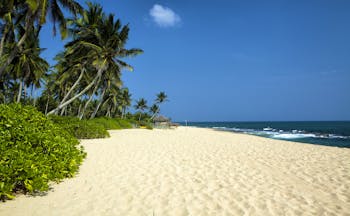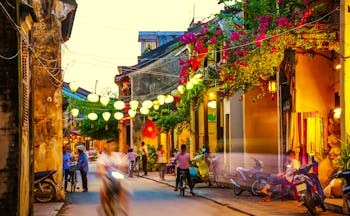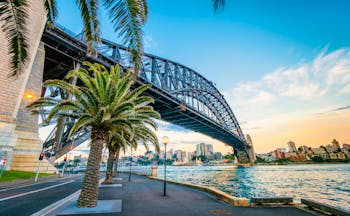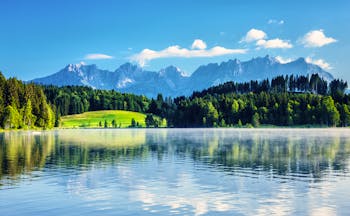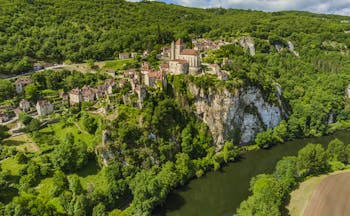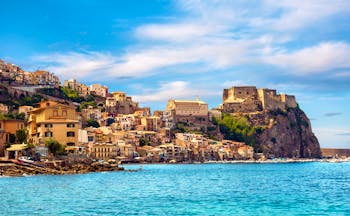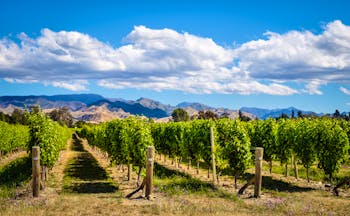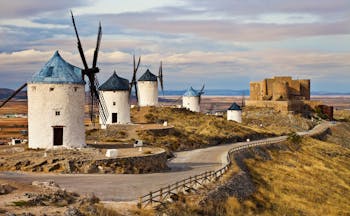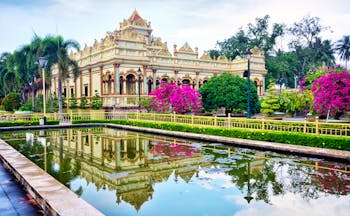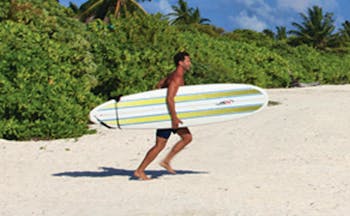Luxury Swiss grand touring holiday by train visiting mountains and lakes of Switzerland with journeys on three scenic trains
This 9-night romantic, Swiss rail touring holiday begins with a rail or air journey into Geneva, from where you travel on to Lausanne for your first night in Switzerland. From Lausanne you travel along the lake to Montreux. Here, you change trains and head for Visp, where you change again for Zermatt, taking the narrow gauge, single track train to the mountain resort at the foot of the Matterhorn. Spend two nights in Zermatt, perhaps with a ride on the Gornergratbahn. Then return by train to Brig, where you change for Domodossola to join the Centovalli Express. This iconic train journey is one of the most romantic in Europe and takes you through to Locarno. Enjoy Swiss Lake Maggiore and the colourful streets here, before heading north to Lucerne on the Gotthard Panorama Express train and then boat. Your time in Lucerne allows you to explore this picturesque lakeside city. From Lucerne it’s over the mountains towards Interlaken and up into the scenic Simmental to Zweisimmen, where you join the GoldenPass Line for the remaining journey into the Saanenland. Your last stop is in Schoenried near Gstaad, before traveling again by the GoldenPass Line to Montreux, and then on to Geneva airport for your return flight. If you intend to return home by train, we recommend spending a night in Geneva before departure.
Highlights
Lake Geneva • Lausanne • Visp • Zermatt • Matterhorn • Certovalli Express • Locarno • Ascona • Gotthard Panorama Express • Steam Boat • Lucerne • GoldenPass Line • Saanenland • Schoenried • Gstaad • Geneva
Day by day
Travel by rail or by air from London to Geneva on your first day. Perhaps spend an hour or two exploring the city, home to fine watch-making, the headquarters of the UN, and the Jet d’Eau fountain. Wander around the Vielle-Villa, the largest Old Town in Switzerland, stopping at the St Pierre Cathedral. From Geneva, catch a train along the northern shore of the lake to Lausanne. During your time in Lausanne, choose from its many elegant attractions; seek out the impressive historic monuments as well as the new, modern additions. Lausanne Cathedral is believed to be one of Europe’s most beautiful Gothic monuments, crowned by spires of unusual purple and orange hues. A new Olympic Museum has opened in the heart of Lausanne’s Old Town; three levels depict Olympic history in all its colourful grandeur. Beside the Olympic Park is the promenade at Ouchy Harbour, which, when lit up in the evening, will be one of the highlights of your trip. The promenade takes you from the gardens along to the Haldimand Tower, the Bellerive Swimming Pool, the Chateau d’Ouchy, and the port. Enjoy dinner in this beautiful area before returning to your hotel. You spend one night in Lausanne.
Today you travel by train from Lausanne to Zermatt. This train journey takes just under three hours, passing the 80 hectares of the stunning Lavaux terraced vineyards, Montreux, Chillon Castle and Martigny, pausing at Visp where you change trains for the narrow gauge, single track railway to the mountain resort of Zermatt. As you enter Zermatt, the area’s crowning glory will make itself apparent: the Matterhorn. Around it, over 400km of walking and hiking paths vein the landscape, allowing you to capture stunning panoramas of both Zermatt and the Matterhorn while uncovering more of the Alpine flora and fauna. You spend two nights in Zermatt.
From Zermatt you can be transported high up into the mountains, reaching 3000m above sea level, and the Glacier Paradise cable car transports you up to Europe’s highest viewing platform. To extend both your experience of the railways of Valais and the mountains, take the Gornergratbahn, the highest open-air rack railway in Europe and the first to be electrified in Switzerland in 1898, up to the summit of the Gornergrat, from where you can bask in views of 38 mountain peaks including the Matterhorn. Consider visiting the Hornlihutte, where for decades climbers have famously stayed as they prepare to climb the Matterhorn, via the Hornli Ridge, the Zmutt Ridge, or the north wall. For something wholly unique, spend an hour or two at the Zermatlantis Matterhorn Museum, a faithfully recreated archaeological site. After a thrilling and busy day exploring this dynamic area, dine in one of Zermatt’s abundant gourmet restaurants or back at your chosen hotel.
You board the Glacier Express at Zermatt and travel through the enchanting village of St Niklaus, punctuated by alpine chalets, rustic houses, and golden and green trees, to Brig. Here you might catch a glance of the 17th century Stockalper Castle, the emblem of Upper Valais and the largest 17th century private building in Switzerland. Change trains for Domodossola, where the Centovalli Express railway begins in earnest. Reputedly one of the most romantic train journeys in Europe, the train will take you through picturesque small villages in both northern Italy and southern Switzerland. The journey will take you through Re, home to the imposing Sanctuary of the Madonna of the Blood, which stands perched on the edge of a sheer cliff, before crossing over the border. Gently sloping valleys are interspersed with narrow gaps, tunnels, and bridges that reach across channels of thrashing white and turquoise water. In Ticino, the Centovalli Express ends in Locarno and you transfer on to your hotel where you spend two nights.
From Ascona you can appreciate the Mediterranean feel of the canton of Ticino, but with the bustle of Locarno at a distance. In Locarno, however, you may wish to visit one of the many 16th and 17th century churches, the 15th century Sanctuary of the Madonna del Sasso, or the Visconti Castle and its permanent exhibition of Roman glass. Should your visit fall on a Thursday, attend the local market to sample a few delicacies and watch the streets really come to life with colour and enthusiasm. Outside Locarno, adventurous guests may attempt to climb the Cadada Cimetta, from which you can see both the highest and lowest points of Switzerland simultaneously: the Valais High Alps and Lake Maggiore.
You will next embark on a route shaped by the legend of the Swiss National Hero of Liberty: Wilhelm Tell. Begin this journey by catching a train to Bellinzona, home to three of Switzerland’s best-preserved Medieval castles, where you may need to change for Fluelen. This train journey weaves its way along the valleys of Ticino, passing the waterfalls of Biasca, the Italianate architecture of Faido, a series of historic isolated chalets, and the town of Airolo. On your way out of Ticino, you will pass through the Gotthard Strassentunnel, as well as the complex network of rail lines in Goschenen. Navigate the Gotthard Loop Tunnels as you travel through the canton of Uri towards the southernmost point of Lake Lucerne. The railway track follows the course of the Reuss River, across flat, wide valleys as it loses altitude. In Fluelen, disembark the train and make your way to the nearby marina. Board the Gotthard Panorama Express steamboat or salon motorboat as you begin the true exploration of Wilhelm Tell’s story. Pass the Rutli Meadows, where Friedrich Schiller’s telling of the tale is set, and which was also the site on which a treaty was signed in 1291 between Lake Lucerne’s neighbouring cantons. The boat also stops off in Sisikon, home to Tell’s Chapel and Tell’s Slab, where Wilhelm Tell reputedly jumped from the bailiff’s boat and pushed it back into the stormy lake waters in the original story. Disembark from the boat at the lido of the Swiss Museum of Transport in Lucerne where you stay next. You spend two nights in Lucerne.
An essential visit on any stay in Lucerne is the Chapel Bridge, the city’s main landmark and the most photographed monument in Switzerland. Walk along the bridge, taking in the views of the Reuss River, the so-called Water Spike, and the Water Tower. For both historical significance and architectural beauty, visit the 17th century Jesuit Church, which overlooks the water and is topped by two droplet-shaped domes. Above the city is the Musegg Wall, a 14th century structure that once protected the city within. Though the city now sprawls outside of this wall, the nine defensive towers still remain, three of which are open to the public. Enjoy lunch in a pavement café on the Kornmarkt Square, beside the colourful Pfistern Guildhall, the Hirschenplatz Square, or the Weinmarkt Square, where Lucerne swore its federal oath with Schwyz, Uri, and Unterwalden. To see some exemplary Swiss culture, visit the prestigious KKL Luzern gallery, the Rosengart Collection of works by Picasso and Klee, the Wagner Museum in Tribschen, and the Swiss Museum of Transport. Finish your days with a sumptuous dinner back at your hotel, or in one of Lucerne’s many gourmet restaurants.
The first part of your next journey takes you to Interlaken via the Brunig Pass. Here, you can choose to stop off and spend a few hours enjoying the town’s remarkable location before boarding another train to Zweisimmen via the Simmental, where you catch the GoldenPass Line for the remainder of the journey to the Saanenland. The distinctive golden carriages of the GoldenPass Line take you from Zweisimmen, the gateway of the Saanenland, to Schoenried or Gstaad where you stay for two nights.
On the border between the cantons of Bern and Vaud, the Saanenland marks the surreal convergence of five individual valleys. Schoenried itself sits on slightly higher ground than its famous neighbour, Gstaad. The area is known for its delicious Alpine dairy products, which are served in many of the gourmet restaurants that line Gstaad’s main promenade. The Moelkerei Gstaad allows visitors to taste a selection of the 3,000 cheeses produced in the Saanenland. We recommend spending a few hours in the Saanenland joining the dots between the traditional farmhouses that surround the fields outside Gstaad, and perhaps venturing further out on one of the hundreds of Alpine trails and paths. Adventurous visitors will want to take a trip up to Glacier 3000 to take in the views of 24 of the surrounding mountains that measure above 4000m. In the evenings, retire to your hotel in Schoenried or Gstaad for a gourmet dinner and a drink beside the cosy fireplace.
Board the GoldenPass Line for the two-hour journey from Schoenried to Montreux. After passing through Gstaad, the GoldenPass Line crosses the border into Vaud, stopping first in Rougemont, and then Chateau-d’Oex. Here the mountainscapes are dotted with quaint chalets, small churches, and petit castles; an image that is very typical of the Pays-d’Enhaut. The villages you will pass next all retain their own individual architectural character, emerging out of plumes of evergreen trees. In Rossiniere and Montbovon, passengers can view the startling translucent turquoise water that runs in rivers crossed by ancient wooden bridges. At Les Avants, the train begins to wind its way down the hillside and steep vineyards that line the slopes towards Montreux on the lakeside, where you change trains for Geneva airport and your return flight. If you intend to travel home by train, we recommend spending an extra night in Geneva to break up the journey.
I wanted to thank you for organising such a great trip - we have absolutely loved it. Really it couldn’t have all gone better - thank you for organising it so perfectly for us.Mrs C, June 2024
Holiday price guide From about £2,810 per person based on two people sharing a double room and including for second class rail travel. First class supplement from £510 per person.
Holiday Code CHBR09
Call us on 01392 441245
Luxury Swiss grand touring holiday by train visiting mountains and lakes of Switzerland with journeys on three scenic trains
Travel by rail or by air from London to Geneva on your first day. Perhaps spend an hour or two exploring the city, home to fine watch-making, the headquarters of the UN, and the Jet d’Eau fountain. Wander around the Vielle-Villa, the largest Old Town in Switzerland, stopping at the St Pierre Cathedral. From Geneva, catch a train along the northern shore of the lake to Lausanne. During your time in Lausanne, choose from its many elegant attractions; seek out the impressive historic monuments as well as the new, modern additions. Lausanne Cathedral is believed to be one of Europe’s most beautiful Gothic monuments, crowned by spires of unusual purple and orange hues. A new Olympic Museum has opened in the heart of Lausanne’s Old Town; three levels depict Olympic history in all its colourful grandeur. Beside the Olympic Park is the promenade at Ouchy Harbour, which, when lit up in the evening, will be one of the highlights of your trip. The promenade takes you from the gardens along to the Haldimand Tower, the Bellerive Swimming Pool, the Chateau d’Ouchy, and the port. Enjoy dinner in this beautiful area before returning to your hotel. You spend one night in Lausanne.
Today you travel by train from Lausanne to Zermatt. This train journey takes just under three hours, passing the 80 hectares of the stunning Lavaux terraced vineyards, Montreux, Chillon Castle and Martigny, pausing at Visp where you change trains for the narrow gauge, single track railway to the mountain resort of Zermatt. As you enter Zermatt, the area’s crowning glory will make itself apparent: the Matterhorn. Around it, over 400km of walking and hiking paths vein the landscape, allowing you to capture stunning panoramas of both Zermatt and the Matterhorn while uncovering more of the Alpine flora and fauna. You spend two nights in Zermatt.
From Zermatt you can be transported high up into the mountains, reaching 3000m above sea level, and the Glacier Paradise cable car transports you up to Europe’s highest viewing platform. To extend both your experience of the railways of Valais and the mountains, take the Gornergratbahn, the highest open-air rack railway in Europe and the first to be electrified in Switzerland in 1898, up to the summit of the Gornergrat, from where you can bask in views of 38 mountain peaks including the Matterhorn. Consider visiting the Hornlihutte, where for decades climbers have famously stayed as they prepare to climb the Matterhorn, via the Hornli Ridge, the Zmutt Ridge, or the north wall. For something wholly unique, spend an hour or two at the Zermatlantis Matterhorn Museum, a faithfully recreated archaeological site. After a thrilling and busy day exploring this dynamic area, dine in one of Zermatt’s abundant gourmet restaurants or back at your chosen hotel.
You board the Glacier Express at Zermatt and travel through the enchanting village of St Niklaus, punctuated by alpine chalets, rustic houses, and golden and green trees, to Brig. Here you might catch a glance of the 17th century Stockalper Castle, the emblem of Upper Valais and the largest 17th century private building in Switzerland. Change trains for Domodossola, where the Centovalli Express railway begins in earnest. Reputedly one of the most romantic train journeys in Europe, the train will take you through picturesque small villages in both northern Italy and southern Switzerland. The journey will take you through Re, home to the imposing Sanctuary of the Madonna of the Blood, which stands perched on the edge of a sheer cliff, before crossing over the border. Gently sloping valleys are interspersed with narrow gaps, tunnels, and bridges that reach across channels of thrashing white and turquoise water. In Ticino, the Centovalli Express ends in Locarno and you transfer on to your hotel where you spend two nights.
From Ascona you can appreciate the Mediterranean feel of the canton of Ticino, but with the bustle of Locarno at a distance. In Locarno, however, you may wish to visit one of the many 16th and 17th century churches, the 15th century Sanctuary of the Madonna del Sasso, or the Visconti Castle and its permanent exhibition of Roman glass. Should your visit fall on a Thursday, attend the local market to sample a few delicacies and watch the streets really come to life with colour and enthusiasm. Outside Locarno, adventurous guests may attempt to climb the Cadada Cimetta, from which you can see both the highest and lowest points of Switzerland simultaneously: the Valais High Alps and Lake Maggiore.
You will next embark on a route shaped by the legend of the Swiss National Hero of Liberty: Wilhelm Tell. Begin this journey by catching a train to Bellinzona, home to three of Switzerland’s best-preserved Medieval castles, where you may need to change for Fluelen. This train journey weaves its way along the valleys of Ticino, passing the waterfalls of Biasca, the Italianate architecture of Faido, a series of historic isolated chalets, and the town of Airolo. On your way out of Ticino, you will pass through the Gotthard Strassentunnel, as well as the complex network of rail lines in Goschenen. Navigate the Gotthard Loop Tunnels as you travel through the canton of Uri towards the southernmost point of Lake Lucerne. The railway track follows the course of the Reuss River, across flat, wide valleys as it loses altitude. In Fluelen, disembark the train and make your way to the nearby marina. Board the Gotthard Panorama Express steamboat or salon motorboat as you begin the true exploration of Wilhelm Tell’s story. Pass the Rutli Meadows, where Friedrich Schiller’s telling of the tale is set, and which was also the site on which a treaty was signed in 1291 between Lake Lucerne’s neighbouring cantons. The boat also stops off in Sisikon, home to Tell’s Chapel and Tell’s Slab, where Wilhelm Tell reputedly jumped from the bailiff’s boat and pushed it back into the stormy lake waters in the original story. Disembark from the boat at the lido of the Swiss Museum of Transport in Lucerne where you stay next. You spend two nights in Lucerne.
An essential visit on any stay in Lucerne is the Chapel Bridge, the city’s main landmark and the most photographed monument in Switzerland. Walk along the bridge, taking in the views of the Reuss River, the so-called Water Spike, and the Water Tower. For both historical significance and architectural beauty, visit the 17th century Jesuit Church, which overlooks the water and is topped by two droplet-shaped domes. Above the city is the Musegg Wall, a 14th century structure that once protected the city within. Though the city now sprawls outside of this wall, the nine defensive towers still remain, three of which are open to the public. Enjoy lunch in a pavement café on the Kornmarkt Square, beside the colourful Pfistern Guildhall, the Hirschenplatz Square, or the Weinmarkt Square, where Lucerne swore its federal oath with Schwyz, Uri, and Unterwalden. To see some exemplary Swiss culture, visit the prestigious KKL Luzern gallery, the Rosengart Collection of works by Picasso and Klee, the Wagner Museum in Tribschen, and the Swiss Museum of Transport. Finish your days with a sumptuous dinner back at your hotel, or in one of Lucerne’s many gourmet restaurants.
The first part of your next journey takes you to Interlaken via the Brunig Pass. Here, you can choose to stop off and spend a few hours enjoying the town’s remarkable location before boarding another train to Zweisimmen via the Simmental, where you catch the GoldenPass Line for the remainder of the journey to the Saanenland. The distinctive golden carriages of the GoldenPass Line take you from Zweisimmen, the gateway of the Saanenland, to Schoenried or Gstaad where you stay for two nights.
On the border between the cantons of Bern and Vaud, the Saanenland marks the surreal convergence of five individual valleys. Schoenried itself sits on slightly higher ground than its famous neighbour, Gstaad. The area is known for its delicious Alpine dairy products, which are served in many of the gourmet restaurants that line Gstaad’s main promenade. The Moelkerei Gstaad allows visitors to taste a selection of the 3,000 cheeses produced in the Saanenland. We recommend spending a few hours in the Saanenland joining the dots between the traditional farmhouses that surround the fields outside Gstaad, and perhaps venturing further out on one of the hundreds of Alpine trails and paths. Adventurous visitors will want to take a trip up to Glacier 3000 to take in the views of 24 of the surrounding mountains that measure above 4000m. In the evenings, retire to your hotel in Schoenried or Gstaad for a gourmet dinner and a drink beside the cosy fireplace.
Board the GoldenPass Line for the two-hour journey from Schoenried to Montreux. After passing through Gstaad, the GoldenPass Line crosses the border into Vaud, stopping first in Rougemont, and then Chateau-d’Oex. Here the mountainscapes are dotted with quaint chalets, small churches, and petit castles; an image that is very typical of the Pays-d’Enhaut. The villages you will pass next all retain their own individual architectural character, emerging out of plumes of evergreen trees. In Rossiniere and Montbovon, passengers can view the startling translucent turquoise water that runs in rivers crossed by ancient wooden bridges. At Les Avants, the train begins to wind its way down the hillside and steep vineyards that line the slopes towards Montreux on the lakeside, where you change trains for Geneva airport and your return flight. If you intend to travel home by train, we recommend spending an extra night in Geneva to break up the journey.
I wanted to thank you for organising such a great trip - we have absolutely loved it. Really it couldn’t have all gone better - thank you for organising it so perfectly for us.Mrs C, June 2024
Holiday price guide From about £2,810 per person based on two people sharing a double room and including for second class rail travel. First class supplement from £510 per person.
Holiday Code CHBR09
Our prices include
● Scheduled flights from the UK to Geneva return OR rail travel from London to Switzerland return via Paris (first class can be booked at a supplement)
● 8-day Swiss rail flexi pass (first class can be booked at a supplement)
● Journeys on the Centovalli Express, the Gotthard Panorama and the GoldenPass Line as described.
● 1 night’s bed and breakfast in a Superior room at the Hotel Angleterre et Residence, Lausanne
● 2 nights’ bed and breakfast in a Standard room at the Tradition Hotel Julen, Zermatt
● 2 nights’ bed and breakfast in a Standard room at the Romantik Hotel Castello Seeschloss, Ascona
● 2 nights’ bed and breakfast in a Classic room at the Hotel Wilden Mann, Lucerne
● 2 nights’ bed and breakfast in a Classic double at the Gstaaderhof, Gstaad
● Concierge service and Expressions Holidays regional helpful hints
Our prices do not include
● Early check-in or late check-out at any hotels (although we can arrange this on request at additional cost)
● Any other services not mentioned above, such as transfers and meals except breakfast at hotels
● Personal holiday insurance. This is essential and cover should be in place from when you book the holiday.
● Local tourist tax, usually between Swiss Francs 1 and 3 per person per night, and payable locally to the hotel
● Transfers in Switzerland station to hotel unless offered by your hotel
Call us on 01392 441245
Luxury Swiss grand touring holiday by train visiting mountains and lakes of Switzerland with journeys on three scenic trains
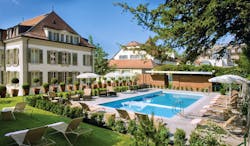
Hotel Angleterre et Résidence is a charming, traditional, Swiss-style, 4-star hotel in a prime location. Delicious cuisine, exceptional service and immaculate grounds offer guests a truly relaxing and indulgent experience.
Superior room
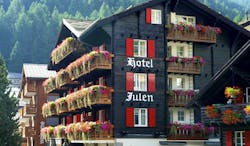
Tradition Hotel Julen is a 4-star chalet hotel with a boutique Alpine ambience in a stunning location in Zermatt. Excellent dining and spa facilities and comfortable accommodation make it an excellent base from which to explore the area.
Standard double room
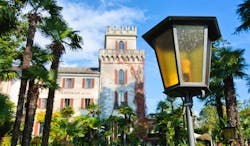
Romantik Hotel Castello Seeschloss is a charming 4-star boutique hotel in a beautiful waterfront location. With comfortable accommodation and delicious cuisine, as well as idyllic, serene views afford guests a luxurious, relaxing retreat.
Standard room
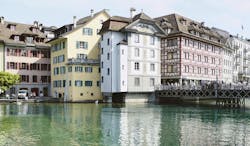
Hotel Wilden Mann is a 4-star boutique hotel in an excellent central location. With gourmet cuisine and stylish, comfortable accommodation, the 500 year-old hotel balances its historic and old-world style with elegance and modern facilities.
Classic room
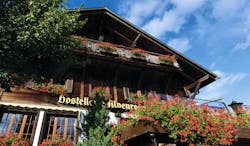
Hotel Alpenrose is a 4-star boutique hotel with outstanding restaurant situated in a charming village near Gstaad, ideal for taking the train and cable cars to visit the surrounding mountains. Enjoy the panoramic views from the terrace over the valley with Gstaad below and the mountains all around.
Standard ‘Rellerli’ double room
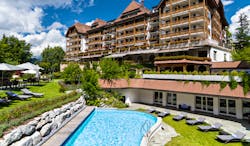
The Park Gstaad is a 5-star, grand hotel in an alpine chalet-style situated on a slight hill above Gstaad enjoying panoramic views of the surrounding mountains and pastures.
Superior forest view room
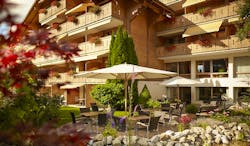
The Hotel Gstaaderhof is a boutique, chalet-style hotel in the centre of the Alpine town of Gstaad. Two restaurants, hotel bar, extensive wellness centre.
Classic double room
I wanted to thank you for organising such a great trip - we have absolutely loved it. Really it couldn’t have all gone better - thank you for organising it so perfectly for us.Mrs C, June 2024
Holiday price guide From about £2,810 per person based on two people sharing a double room and including for second class rail travel. First class supplement from £510 per person.
Holiday Code CHBR09
Call us on 01392 441245
Luxury Swiss grand touring holiday by train visiting mountains and lakes of Switzerland with journeys on three scenic trains
About Lake Geneva
An Expressions tailor-made holiday to Lake Geneva is an ideal way to experience the beauty and serenity of this Swiss region. Marking a crescent-shaped segment of the France-Switzerland border, Lake Geneva is named after diplomatic, historic Geneva. French spa towns on the southern shore look across to the Swiss Riviera on the northern side, characterised by grand palatial buildings and hotels, promenades lined with trees, and tumbling fountains. Lake Geneva is popular for water sports and hiking holidays, as well as relaxing lakeside spa breaks; and, in the winter, it is close enough to the ski slopes to make a very laid-back skiing destination. Chic towns and villages sit behind rows of palm trees, basking in the Mediterranean climate, sheltering gourmet restaurants, luxury boutique shops, and a range of stunning Swiss hotels. Prestigious buildings, at the seat of European politics, call these idyllic towns home, adding a sense of importance to the atmosphere of the peaceful streets. There is perhaps nowhere more glamorous in Switzerland than Lake Geneva, and nowhere where the history and culture is so grand and visually captured in the buildings, parks, and gardens. With such close proximity to Geneva airport and the major railway lines, Lake Geneva is an excellent first or last stop on a touring holiday.
Highlights of Lake Geneva
Montreux, on the most eastern point of the lake is most famous for the Montreux Jazz Festival, which is held in international esteem. One of the most iconic sights, for both Switzerland and Montreux, is of Chillon Castle, jutting out on a rocky outcrop into the lake waters. This castle cannot be missed because of its fairy-tale beauty. You can also begin to explore the landscape around Montreux by rail. One railway takes you across Alpine meadows to Rochers-de-Naye at more than 2000m above sea level, from which you can sometimes see the Jet d'Eau in Geneva. The Swiss Chocolate Train, adorned with lavish Belle Epoque carriages, travels to the village of Gruyeres, where characterful old cobbled streets are lined with townhouses containing cafes and three museums. An imposing medieval castle sits at the top of the village. You can also reach the Maison Cailler on the Chocolate Train, where you learn about traditional Swiss chocolate-making and even make some of your own. The Vineyard Train (number S31) will take you through the 800 hectares that make up the Lavaux Terraced Vineyards from Vevey to Puidoux-Chexbres. The vineyards are the largest living cultural site in Switzerland and a recognised UNESCO World Heritage Site. Further west from the Lavaux Vineyards is Lausanne, home to the International Olympic Committee headquarters, but perhaps best known for simply being a particularly romantic and beautiful Swiss town. Gardens, promenades, and lakeside pathways ensure that your days here are as picturesque as they are cultural. At Lausanne's heart stands the Cathedral, believed to be one of Europe's most beautiful Gothic monuments. The purple and orange hues of its two main spires are visible throughout the town. It was originally built in the 12th and 13th centuries. In contrast with the Cathedral, immersed in the history of the cobbled Old Town, a new Olympic Museum has recently opened. Interactive displays illustrating the colourful history of the games are spread over three levels and include more than 1,000 objects and 150 screens. One of the highlights of the museum, however, is the Olympic Park. The artworks, sports sculptures, and beautiful patches of well-maintained nature provide a stunning setting for this modern cultural venture. From here, you can wander down the promenade at Ouchy, an area that is unrelentingly popular with residents. This promenade takes you to the Haldimand Tower, the Bellerive Swimming Pool, the Chateau d'Ouchy, and the port.
Cultural highlights of Lake Geneva
Any stay on Lake Geneva remains incomplete without a visit to the city that gives it its name. One of the key features of Geneva's cultural heritage is its place as the origin of fine watch-making. Workshops, boutiques, and museums all provide an insight into this prestigious craft. Even the Jet d'Eau fountain bears some connection, as it originally harnessed the power of the Rhone for the craftsmen of Geneva. Today, it acts as a captivating, animate monument to the skills, craft, and natural forces of the city. Geneva is also home to the Palais des Nations, the European headquarters of the UN. Guided tours take visitors through the building, which seems to blend geometric modern design with classical, palatial style. Geneva's Old Town, or Vieille-Villa, is the largest in Switzerland, laced with narrow alleyways and charming squares, and centred around the St Pierre Cathedral. 157 steps will take visitors to the top of the cathedral tower in order to appreciate the remarkable views over the fascinating jumble of unique townhouses. A very unique feature of Geneva is the Flower Clock in the Jardin Anglais. This precise and beautiful clock has the longest second hand in the world. Visitors interested in Swiss art and modern culture should spend an afternoon in the Quartier des Bains, wandering around the MAMCO and the Centre d'Art Contemporain before enjoying dinner in a chic bistro. Mediterranean Carouge is Switzerland's gateway to the south, with abundant Sardinian style. Finish your exploration with one of the four world-exclusive museums: the International Museum of the Red Cross and Red Crescent, Le Musee International de la Reforme, the Patek Philippe Museum, and the Bodmer Foundation Library and Museum.
Festivals in Lake Geneva
Much of the canton of Geneva's culture is built around a celebration of its history and traditions. Perhaps one of the liveliest celebrations is the Oktoberfest, though many more unusual festivals prove equally enjoyable. In the first two weeks of February, the Antigel Festival brings a variable programme of music, dance, and other performances to the less likely stages. In March, the International Geneva Motor Show, largest of its kind in Europe, unveils a range of new innovative designs at the Palexpo Exhibition Centre. Similarly, in April you can visit the International Exhibition of Inventions, New Techniques, and Products in the same venue. On specific dates of the year, usually mid-May, a selection of museums stay open for the whole night, an event that is also celebrated in a number of bars. Also in May is a Day of Open Wineries, where upwards of 90 wineries open their doors for free to wine-touring visitors. A charge of 5CHF at one winery will enable you to taste wines at every other winery for no further charge. In June and July, parks, gardens, and secluded outdoor spots on the lake shores play host to a range of live music and DJ sets at the Ecoutes au Vert Festival. In the middle of June each year, Lake Geneva is transformed into the largest sailing regatta in Europe, with over 500 boats competing. Geneva's largest music festival is the Geneva Music Festival in late June, specialising in a range of musical genres, and accompanied by an array of food stalls. Impossible to forget is the Montreux Jazz Festival, founded in 1967, that brings an eclectic range of performances to the lakeside stages, not limited to Jazz. The Cine Transat, hosted in one of Geneva's parks, features a series of French and English films. The Prelude to the Geneva Festival and the Geneva Festival itself take place from the middle of July until the first week of August and are widely believed to be the highlight of summer in the region. Carnival rides, concerts, stalls with Swiss delicacies and street food, parades, and variety performances take over the lake shores, topped off with unique firework displays each and every night. The Festival de la Batie from the end of August to mid-September exhibits the works of many local artists from a range of disciplines in Batie Park. The Nuit des Bains sees several galleries in the Quartier des Bains open their doors for free. For a taste of Geneva's history, watch l'Escalade in the Old Town in the second week of December, which commemorates that defence of the city against the Duke of Savoy in 1602.
Gastronomy in Lake Geneva
With over 1,000 restaurants, Geneva is recognised as the capital of culinary delicacies in Switzerland. For decadent dining, choose one of the hotels that line the lake shores; for foreign cuisine, head to the Paquis district; for traditional Swiss dishes, dine in Geneva's Old Town; for Italian restaurants and French cafes, go to Eaux Vives; and for experimental, chic restaurants, eat in Carouge. Some ingredients to look out for in particular are cheeses from Gruyere, oil from Severy, charcuterie, perch, fera, char, and leeks. Vaud, the region in which Lake Geneva sits, is Switzerland's largest wine-growing region, and the most prominent grapes are Chasselas, Pinot Noir, and Gamay. You may also discover some Tartiflette, which originated over the French border in Haute-Savoie, made with Reblocohon cheese.
Call us on 01392 441245
Luxury Swiss grand touring holiday by train visiting mountains and lakes of Switzerland with journeys on three scenic trains
About Lake Lucerne
An Expressions tailor-made holiday to Lake Lucerne allows travellers to be immersed in history, folklore, and bustling modern culture. Lake Lucerne brings together everything that makes Switzerland in summer so special. The city of Lucerne itself is one of the most beautiful cities in the world. White-walled, tiled-roof townhouses crowd together on the water's edge; bridges on stilts take visitors from one side of the river to the other; and the high original rampart wall is visible in the distance. Outside the city, you are free to enjoy the Alpine panoramas from a boat, or from one of the hiking trails that score the mountainsides. Thrilling extreme sports can be enjoyed alongside serene rounds of golf in quilted green valleys, or hours can be whiled away in one of the smaller towns and villages around the lakeside. Further inland, you can uncover villages virtually untouched by commercial tourism that seem to be preserved in a bubble of authenticity. Any stay in the Lake Lucerne region will be one packed full of stunning views, nature excursions, and exhilarating hours on the mountainsides or on the water.
Highlights of Lake Lucerne
Begin your exploration of the Lake Lucerne Region with the famous city itself. To get your bearings, wander along the river or lakeside, stopping first at the Chapel Bridge, Lucerne's main landmark and the most photographed monument in Switzerland. This bridge gets its name from St Peter's Chapel, which stands nearby, and was built in the early 14th century, making it a true testament to its ingenious structure. The Water Tower that stands partway along the bridge once formed part of the city walls, and has served a number of functions, including that of an archive, prison, and torture chamber. Also part of the city's fortifications is the Spreuer Bridge, which, again, stretches across the Reuss, but with an unusual ochre design characterised by the small red turrets attached above the bridge's supports. The so-called ‘Water Spike,' which regulates the water level in the Reuss River, is recognised for being a truly unique sight, due to the specificities of its engineering. For more stunning, historical structures, visit the 17th century Jesuit Church, with its grand, regal Baroque façade, which was the first large sacral church to be built in Switzerland. High above the city is the Musegg Wall. Built in the late 14th century, the wall remains remarkably well preserved, as do the nine towers, of which three are open to the public. For a taste of traditional Swiss life, visit one of the historical squares hidden down the city streets and enjoy a light lunch or drink in one of the cafes. The Town Hall and Pfistern Guildhall, which is artfully painted, are situated on the Kornmarkt Square; the Hirschenplatz Square is named after an inn that dates back to medieval times; and the Weinmarkt Square is the site on which Lucerne swore its federal oath with Schwyz, Uri, and Unterwalden in the early 14th century.
Cultural highlights of Lake Lucerne
Lucerne is home to a variety of museums and galleries, including the KKL Luzern, the Rosengart Collection of works by Picasso and Klee, the Wagner Museum in Tribschen, and the most well-known of them all, the Swiss Museum of Transport. Once you have explored Lucerne's streets, restaurants, and shops, finish your tour with a visit to the Dying Lion of Lucerne. Commemorating the deaths of the Swiss mercenaries at the attack on the Tuileries at the end of the 18th century, this monument is one of the most moving in Europe. Follow the northern shore of the lake to the picturesque villages of Weggis and Vitznau. Weggis is recognisable from the water by the red-topped church spire at the village's highest point. The scattered houses in both are surrounded by green lawns, clusters of evergreen trees, and gently rising slopes. The Wilhelm Tell Express will take you by boat from Lucerne across the river to Fluelen, passing the iconic spots that feature in the legend of Wilhelm Tell, the best known folk character in Switzerland and the Swiss National Hero of Liberty. The meadows in Rutli, for example, are the setting of Friedrich Schiller's recounting of Tell's tale, and Tell's Chapel in Sisikon is built upon Tell's Slab, where he famously jumped from the bailiff's boat before pushing them back into the storm. Further inland, in the neighbouring cantons that claim sections of Lake Lucerne's shores, are several picturesque towns and villages with their own individual character. The town of Schwyz, in the canton of the same name, provides both a valuable connection with the cities and towns to the east of Lake Lucerne and an equally valuable insight into the traditions and atmospheres of small towns that have retained much of their historical air. The most popular and interesting part of this town, which is mainly characterised by its peaceful streets of chalet-style buildings, is the Hauptplatz. Here, you can admire the painted façade of the Town Hall while enjoying some food at the restaurant of the Hotel Wysses Rossli. Those looking to explore the landscape on foot or by cable car should head towards the two main peaks of the Lucerne area: Pilatus and Rigi. The former was once reputedly the home of a dragon and is now believed to be the final resting place of Pontius Pilatus, but most remarkable are the views across 73 Alpine peaks that can be appreciated from the top. Rigi is known as Queen of the Mountains, from the summit of which you can see 13 lakes, the entire Swiss Mittelland, and the borders into Germany and France. A cable car up to Rigi can be taken from Weggis. To enjoy the scenery by rail, take the funicular railway from Stoos to Fronalpstock or vice versa, the track of which is the world's steepest. Once on the mountainsides, you are at your leisure to embark on cycling tours and hiking tours to unveil the waterfalls and mountain streams, to take a once-in-a-lifetime skydiving or paragliding trip, or to take your time with a round of golf. The range of places and activities that surround Lake Lucerne is given its diversity by the stunning landscape, and by the coming together of so many cantons, each with their own unique culture. We would recommend staying long enough to try a little of everything to truly make the most of this fantastic and inspiring region.
Festivals in Lake Lucerne
Lucerne prides itself on being a city of festivals, a title that it lives up to through its blend of music, food, and theatrical celebrations. The biggest of these is without a doubt the Lucerne Carnival. Beginning on Fat Thursday before Lent begins, the carnival features three massive parades with masks, costumes, bonfires, and displays by the various societies in the area. Music festivals in Lucerne also include the World Band Festival at the end of September, the Lucerne Blues Festival at the beginning of November, the Lucerne Festival at the Piano in mid to late November, the two Lucerne Festivals (at Easter and in summer) which focus on classical music, and the Blue Balls music and art festival in late July. Sports enthusiasts might want to plan their visit in time with the Lucerne Regatta, on the 7th to 9th July 2017, and the Athletics Meeting, also in July.
Gastronomy in Lake Lucerne
The food around Lake Lucerne, like its history, is made diverse by the numerous cantons. Visitors can enjoy high-class gourmet food in stylish modern restaurants, or can enjoy traditional delicacies in smaller, family-run establishments. One example of a popular local dish is the Lozarner Churgelipastete, which comprises of veal and mushrooms cooked inside a puff-pastry casing. Those with a sweet tooth might wish to try the pear bread. To try some Swiss Alpine cheese, we would recommend ordering either the raclette or the fondue, as these are possibly the most typically Swiss dishes available. Finish off your culinary tour of Lucerne with some of the famous Swiss chocolate made by a local chocolatier.
Call us on 01392 441245
Luxury Swiss grand touring holiday by train visiting mountains and lakes of Switzerland with journeys on three scenic trains
About Saanenland
An Expressions tailor-made holiday to Saanenland allows for exploration of this beautiful and peaceful yet bustling Swiss region. Considered a part of the Bernese Oberland, the Saanenland is rich enough to be a region in its own right. Central Gstaad offers a unique and authentic Swiss holiday experience, with quirky shops and restaurants to suit all tastes. Its many luxury chalets remain popular with A-List celebrities. Surrounding Gstaad are nine other villages, such as Schonried, Zweisimmen, Saanen, and Saanenmoser, which prove to be continually popular as winter sports destinations, particularly with skiers. In the summer, however, the Saanenland offers a wealth of exploratory and sporting diversity. Priding itself on being a haven of wellbeing, the Saanenland offers a taste of idyllic nature, whilst remaining one of Switzerland's chicest locations.
Highlights of Saanenland
The Saanenland is based in the convergence of five valleys. Streams, lakes, forests, and verdant slopes therefore provide a 360 degree backdrop to your stay here. The isolated and little-known Lauenensee, for example, is a bubble of peace and tranquillity, with pathways around the lake shores that lead up to a waterfall that crashes between jutting rocks on its way down the mountainside. In the winter, the lake freezes over, and there is every chance you may be the first to leave your footprints in the snow. Gstaad is perhaps what makes the Saanenland so well-known and so deserving of its own individual place as a region in our overview of Switzerland. The traffic-free main promenade is lined with perfectly maintained, authentic Swiss chalets, complete with dark wood peaked roofs, shuttered windows, and balconies. These chalets contain intriguing boutique shops and some of Gstaad's 100 restaurants, which serve anything from Swiss raclette to gourmet, refined cuisine. In the landscape around Gstaad lie a huge range of summer sports opportunities. More than 300km of hiking paths take you up and around the mountains and deep into the valleys. Mountain-biking, paragliding, and golf also remain continually popular with seasonal guests. Schonried hosts a famous toboggan run, while exhilarating downhill scooter rides can be enjoyed from Wispile to Gstaad or Sparenmoos to Zweisimmen. On the River Saane, you can wrestle the torrent on a raft or in a canoe. Schonried, on the so-called ‘sun terrace' above Gstaad, is one neighbouring village that is of particular interest. Schonried is an excellent starting point for many hikes or long walks, due to its sublime scenery and many cableways and high-altitude railways. The picture-postcard village of Zweisimmen is known as the Gateway to the Saanenland. Most notably, however, it is an important station on the iconic route of the GoldenPass Line, and the railway line that links the Bernese Oberland to Montreux. You may wish to visit Zweisimmen for the Rinderberg cable car, which takes you up to one of the largest ski areas in the Saanenland in winter, and up to an intricate network of walking routes in the summer. Various themed trails take you through the different elements of the local culture, such as around the authentic farmhouses with their carved murals, or high up in the mountaintops. There are ten villages in total in the Saanenland, each of which is charming in its own right. Should you have time, we would not discourage visiting as many of these as possible to admire the scenery from multiple angles.
Festivals in the Saanenland
A lesser-known highlight of the area's winter sports opportunities is the Zweisimmen Snow Games in January, featuring a waterslide through the Rinderberg water, ski-cross races, downhill mountain biking, and freestyle parkour. February and March in Gstaad are made all the more enchanting by the Sommets Musicaux de Gstaad, a small classical music festival. The summer sees two large tennis tournaments come to Gstaad: the J. Safra Sarasin Swiss Open Gstaad, and the Ladies Championship Gstaad. The Davidoff Saveurs Gstaad celebrates authentic local cuisine and wine in July. For more traditional celebrations, attend the Suufsunntig, an Alpine festival from July to August hosted on the nearby mountains. Also in the summer, from July to September, is the Gstaad Menuhin Festival, which honours the violinist and conductor after which it was named, with numerous performances of haunting classical music. The Hublot Polo Gold Cup Gstaad in August sees jockeys from all over the world racing Arab horses. Something a little different can be enjoyed at the Country Night Gstaad in September. Across the border into the canton of Vaud is Chateau-d'Oex, which hosts the International Balloon Festival, the most important balloon event in the Alps.
Gastronomy in the Saanenland
As in much of Switzerland, cheese plays an integral part in the local gastronomy of Saanenland. In Chateau-d'Oex and Rougemont, be sure to try the Etivaz cheese, which is made in the cauldrons of Alpine huts. In a quaint gourmet restaurant in Gstaad or on the lush rolling pastures of Schonried, try the fondue or raclette in the environment in which it was intended to be eaten. Local farms, particularly dairy farms, offer breakfast, lunch, and dinner service, with the opportunity to try some of their homemade produce and watch as the cheese is made.
Call us on 01392 441245
Luxury Swiss grand touring holiday by train visiting mountains and lakes of Switzerland with journeys on three scenic trains
About Ticino
An Expressions tailor-made holiday to Ticino allows travellers to witness the sheer diversity of Switzerland as a country. Hailed as having a Mediterranean climate, Ticino is Switzerland's most southerly region. Italianate towns, influenced by the proximity of the Italian border, provide a wholly different culture and atmosphere to the Bernese Oberland, the Saanenland, and other central and northern regions. A smattering of small lakes mark the upper boundary of Ticino, but it is Lake Maggiore and Lake Lugano that dominate the south, prompting many of the long, straight valleys that lead into Italy. The River Ticino winds its way down from its source on the Ticino border, meeting dams, lakes, and trickling and tumbling waterfalls on its way. Palm trees line the lakesides, medieval Italian castles form the centre-points of towns, and colourful, higgledy-piggledy houses look out across the water or from their tiered position on the steep mountainside. Communities here seem to effortlessly blend the feel of southern coastal towns with the rural authenticity of the mountain villages of central Switzerland.
Highlights of Ticino
Two of the main cities in Ticino lie quite close together in the south of the region: Locarno and Lugano. On the banks of Lake Maggiore, Locarno is rich with cultural treasure. Visit the 17th century Church of St Anthony, the 16th century Church of San Francesco, the mid-17th century New Church, or the late 15th century Sanctuary of the Madonna del Sasso to begin your tour of Locarno's beautiful and historic sites. Perhaps most noteworthy, however, is the Visconti Castle, in which there is a permanent exhibition of Roman glass. On Thursdays a market is held in the centre of the town, which always makes for an excellent place to enjoy Locarno at its liveliest, as well as to pick up a few delicacies. Venture outside Locarno to climb the Cadada Cimetta, from the top of which you can see both the Valais High Alps and Lake Maggiore, the highest and lowest points in Switzerland. Follow the paths of the Magic Valley or the Verzasca Valley to witness the turquoise-green, crystal-clear waters that flow there. For a more leisurely day out, enjoy a boat cruise on Lake Maggiore. As you leave Locarno and head west down the valley towards Italy, you will see the rocky gorges that prove so popular with cliff divers. Eerie tunnels and caverns have been carved out over time, providing ethereal little spots to stop off on your travels.
Cultural highlights of Ticino
East of Locarno is Bellinzona, a town remarkable in that it is the most Italianate town in Switzerland and capital of Ticino. The central medieval castle and its two neighbours are among Switzerland's best preserved, coming together to form a picturesque UNESCO World Heritage Site. The ramparts of the central castle run alongside the vineyards within, with lush grass carpeting the fortified walls. North of Locarno, you will come across Tegna, the site of some interesting prehistoric ruins. Continue along this route towards the Italian border on the Centovalli Express to discover the old wine press in the village of Cavigliano, the museum and cableway in Intragna, the cable car up to the solitary, traffic-free hamlet of Rasa from Verdasio, and finally, across the Italian border to Re, where the stunning, yet imposing, Sanctuary of the Madonna of the Blood stands on the very edge of a dramatic cliff. In eastern Ticino is Biasca, a town where a waterfall cascades down the mountainsides, under bridges and over rocks that have been smoothed by time. Towns and villages such as Airolo, Lavizzara, Acquarossa, Blenio, and Brione all offer alternative views on this beautiful region. Any visit to Ticino is incomplete without a few hours spent in Lugano. Famous for its eponymous lake, San Salvatore Mountain, and Monte Bre, Lugano is a quintessentially ‘Ticino’ town. Take the funicular railway from Casserate as high as possible up Monte Bre to witness the phenomenal panoramas and enjoy the traditional Swiss rail experience.
Festivals in Ticino
As with much of Switzerland, there is a high focus on dairy products in both the regional dishes and their self-identification. To appreciate Swiss dairy products in Ticino, head to Ambri Quinto in the Leventina Valley at the end of September to enjoy the Agriculture and Cheese Fair. The first weekend in October brings with it a celebration of autumn. In Lugano, this autumn festival focuses on local products, folkloric music, and small dramatic shows. In Ascona, the autumn festival celebrates the versatile chestnut, with jams, cakes, cheese dishes, and entertaining concerts. Ascona's unique carnival is celebrated on Mardi Gras on the lake promenade. In Muralto on the second Sunday of March there is a fish festival beside the water, involving a fishing contest, music, games, and food stalls. Beside the smooth rocks of Solduno, on St Joseph's Day in March, the streets are filled with the smell of the speciality Tortelli, a fritter whose recipe is strictly guarded.
Gastronomy in Ticino
The varied and delicious specialities of Ticino may very well be the highlight of your trip, influenced by hearty Swiss cuisine, as well as Italy's Mediterranean flavours. One particular feature of dining here are the ‘grotto' restaurants. Usually housed in picturesque stone farmhouses, with abundant flower boxes, shuttered windows, and vast terraces canopied by views on which customers eat fresh, home-cooked food. Popular so-called ‘slow foods' include farina bona flour, cicitt sausages, Zincarlin cheese and shortbread biscuits. At the heart of many dishes you may come across are polenta and Merlot wine, which can also be sampled at a local winery. Originally cooked in a large cauldron like porridge, polenta is now best served alongside braised beef. Before leaving Switzerland, ensure you sample some of the world-famous fondue.
Call us on 01392 441245
Luxury Swiss grand touring holiday by train visiting mountains and lakes of Switzerland with journeys on three scenic trains
About Valais
An Expressions tailor-made holiday to Valais incorporates the region stretching from the southeastern-most shore of Lake Geneva to its borders with Ticino, Italy, Uri, and Bern. Perhaps most famous for the icy Alpine resort of Zermatt, Valais is a canton that captures a blend of those Swiss mountain resorts and northern Italy's flourishing wine-producing vineyards. This mix is complicated further by the dual-language of the canton; the west of Valais speaks French, and the east speaks German. Terraced vineyards cloak the slopes of southern Valais, uniquely watered by glacier run-off, channelled through ‘bisses,' which are historic irrigation channels. The various and diverse ‘terroirs’ have led to the cultivation of a great number of grape types. Older varieties, such as Amigne, Petite Arvine, and Cornalin, are still carefully grown alongside more robust varieties, such as Chasselas, Gamay, and Pinot. Valais is also popular amongst cycling, mountain-biking, and hiking enthusiasts. Over 8000km of marked hiking paths line the mountainsides, and well-maintained and well-marked cycling paths are combined with high-altitudes to establish a network that is unrivalled in Switzerland. Cycle from mountain to mountain, passing thrashing rivers, trickling streams, tranquil lakes, and thick forests to gather, in just a few hours, a vast perspective on Swiss natural beauty.
Highlights of Valais
During your stay in Valais, you will see lush meadows, rivers, and 4000m high mountain peaks topped with all-year ski slopes. Between these peaks, creaking, radiant-white glaciers mould to the gradients of the slopes and filter into the craggy valleys. The most famous mountain in Valais, and possibly the whole of Switzerland, is undoubtedly the Matterhorn. Its distinctive silhouette can be appreciated from miles around, but perhaps best from Zermatt. Take the Matterhorn Glacier Paradise cable car from Zermatt up to 3883m, making it the highest cable car in Europe, to the Panoramic Platform to look out across the other neighbouring 4000m high mountains and glaciers. Before returning to ground level, admire the mesmerising ice sculptures hidden within the Glacier Palace, a series of stunningly carved ice tunnels. Zermatt is an Alpine village known for its winter sports, being as it is one of the most popular skiing destinations in Switzerland. In the summer, when some of the snow has melted, Zermatt is a peaceful community of chic bars and cafes and quaint and characterful chalets. It comes highly recommended to those who enjoy hiking, walking, or simply the sight of those dramatic Alpine panoramas outside your hotel window. Those looking to experience the undisrupted beauty of the landscape but without the strenuous exercise of the hiking routes may wish to take advantage of the excellent local railways and connections. The Gornergratbahn, for example, is Europe's highest cogwheel railway, and its characteristic red carriages take visitors up to stunning Gornergrat. From Zermatt you can also board the Glacier Express to St Moritz in Grisons, which is a continually popular and iconic route. In the north of the Canton of Valais is the Aletsch Glacier, the longest in the European Alps and with the greatest volume. Reaching from the Bernese Oberland to the Rhone River, this UNESCO World Heritage Site is a vast expanse of twisted, mottled ice which navigates sharp spikes of rock and thick clusters of pine forest. Between Bettmeralp and Riederalp, to the southeast of the Aletsch Glacier, is the Aletschji-Grunsee Suspension Bridge. Over 124m of thrilling high-altitude metal bridge hovers above the Massa Gorge, affording the brave and adventurous among us phenomenal, unparalleled views of the glacier. Northwest of Zermatt, towards Martigny, is Verbier, a luxurious ski resort known for attracting very elite clients. If you have the chance, it is worth spending a night here so as to take the first Medran cable car up to the summit of Mont Fort at 3329m to see the sun rise over the mountaintops. At Saas Fee, the Mittelallin funicular railway climbs underground to 3500m, where a revolving restaurant looks out across the Allalin Glacier and others that sit at 4000m.
Cultural highlights of Valais
Sion, in the northern half of Valais, is home to chateaux and palaces galore. Chateau de Tourbillon has a magnificent hilltop position looking down over the Rhone Valley. After a fire in the 18th century, mainly the brooding exterior walls remain, though the site offers a breath-taking, intriguing place for a walk. Opposite the Chateau de Tourbillon, on an equally majestic hill, is the Chateau de Valere. Originally started in the 11th century, the castle was built around an ancient basilica. Today, the castle church holds carved stalls, an apse with beautiful frescoes, and the oldest playable organ in the world, which dates from 1440. While visiting, take a tour around the castle museum, and, in the summer, enjoy one of the concerts held here. Another small castle in Sion houses the Musee d'Art, exhibiting works by artists such as Oskar Kokoschka, Caspar Wolf, and Ernest Bieler. For even more prestigious art collections, visit the Fondation Pierre Gianadda in Martigny, which houses works by the likes of Van Gogh and Picasso, and the Fondation Pierre Arnaud, which is a strikingly modern building with a mirrored exterior and a dramatic mountainous location in Crans Montana.
Festivals in Valais
Popular destinations and cultural cities lend themselves to high profile celebrations and festivals, which crop up around Valais at various points in the year. In Sierre, the Marche des Cepages in early September sees residents and visitors walk through the vineyards around the town, while drinking the produce and socialising with the winegrowers themselves. From the middle of August to the middle of September, the Festival de Sion sees international classical artists perform at many local stages, violinists compete, and many smaller free-entry stages pop up. Two weeks at the end of July see Verbier truly live up to its sophisticated reputation with a classical music festival. During the summer months at the Chateau de Valere in Sion, in the evening the castle walls are lit up with colour as part of the fascinating sound-and-light show. Something more unique is the Foire au Lard in Martigny, otherwise known as the Bacon Fair. Held in December, this festival has been around since 1801. In Riederalp, an unusual but very traditional festival takes place, the Chuefladefascht. Local residents throughout history would smash up cow pats and spread it as fertiliser across their fields; now, the game is to strike as many with your weapon of choice as possible and pluck out tombola prizes written down on paper and hidden inside.
Gastronomy in Valais
Valais the largest wine-making region in Switzerland, with plenty of wineries and vineyards open for tastings and tours. Other speciality ingredients include the huge range of savoury spices that grow here, including saffron. These local spices ensure that every dish in Valais' many gourmet restaurants will be seasoned and spiced to perfection. As with much of Switzerland, a very popular dish is the raclette, made using the best Alpine cheeses. For a heartier, homelier meal, seek out a dish that utilises the rich flavour of the local chestnuts, or choose to begin your meal with some fresh rye bread.

